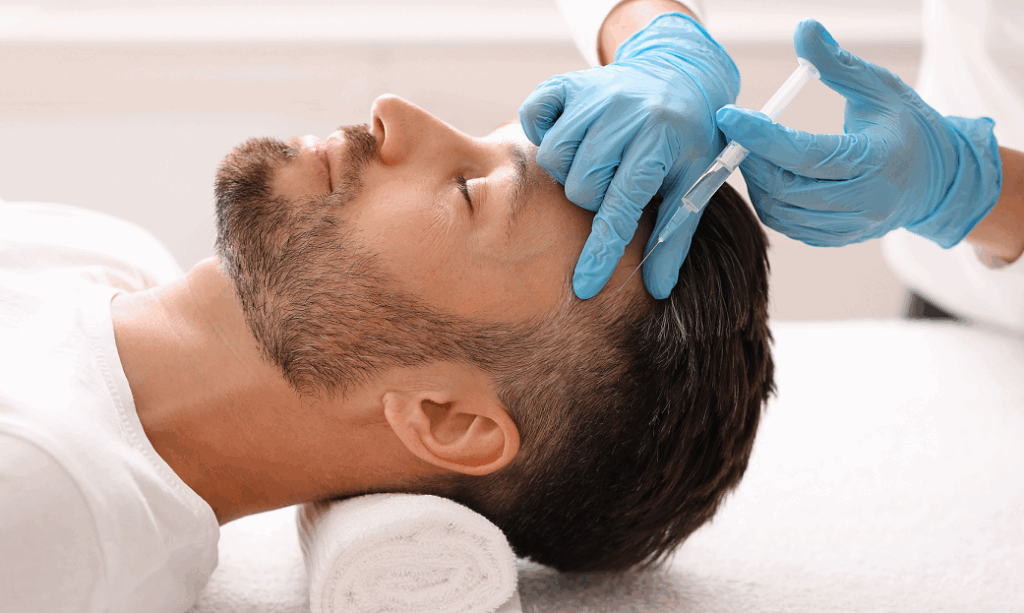PRP Treatment or Plasma Rich Platelet therapy has consistent results in promoting hair growth. This therapy is very effective to promote the growth of any dormant follicles. It also strengthens follicles making the hair still in place, thicker.
PRP Treatment is sometimes known as the Vampire Facial. We draw your bloods and then spin them to separate the white and red blood cells. The PRP (white blood cells) are then re injected into the affected area Rejuvenating the follicles.
At finchley cosmetic salon, We recommend a course of 3 to 6 treatments and then yearly.
Advantages of PRP Treatment for Hair Loss & Scalp Rejuvenation
Naturally stimulates hair growth
Increases hair volume, density and fullness
Increases survival and strengthening of existing hair
Improves hair quality
WHAT ARE THE CAUSES OF HAIR LOSS IN MEN?
The most common cause of hair loss in men is genetic susceptibility and androgenetic alopecia or male pattern baldness (MPB). Other causes of hair loss in men include certain diseases, reaction to certain medications and stressful life events.
WHAT ARE THE CAUSES HAIR LOSS IN FEMALES?
Causes of hair loss in females include genetic susceptibility, extreme stress, a medical condition or treatment. Hair loss is common side effect of chemotherapy, and around 50% of women lose more hair than usual after they’ve given birth.
WHAT IS HAIR GROWTH CYCLE AND HOW IS IT AFFECTED BY HORMONES?
Each strand of hair is subject to a three-phase growth cycle. These phases are:
- ANAGEN (GROWING) STAGE. The anagen stage is the growing period of a hair follicle. This can last between two to six years with average hair growth being approximately 6 inches annually.
- CATAGEN (INTERMEDIATE) STAGE. The catagen stage is the intermediate period of hair growth and marks the end of hair growth.
- TELOGEN (RESTING OR SHEDDING) STAGE. This phase last approximately two to three months after which the hair is shed, and a new hair replaces it.
- Male pattern baldness affects the hair growth process by making the effects of the catagen, phase more severe. DHT, the androgenic hormone that causes male pattern baldness, inhibits and reduces the proper growth of hair follicles in a process called ‘miniaturisation’. ‘Miniaturisation’ affects genetically-susceptible hair follicles resulting in lighter, finer hairs. Over time, this results in hair follicles shrinking and eventually failing to produce hair growth.
WHAT ARE THE DIFFERENT TYPES OF HAIR LOSS(ALOPECIA)?
These include:
- Involutional alopecia is a natural condition in which the hair gradually thins with age. More hair follicles go into the resting phase, and the remaining hairs become shorter and fewer in number.
- Androgenic alopecia is a genetic condition that can affect both men and women. Men typically develop male pattern baldness due to hair loss as early as their teens or early 20s. Male baldness is characterised by a receding hairline and gradual disappearance of hair from the crown and frontal scalp. Women develop female pattern baldness usually in their 40s or later. There is a general thinning over the entire scalp, with the most extensive hair loss at the crown.
- Alopecia areata creates patchy hair loss typically seen in children and young adults and in some cases can result in complete baldness (alopecia totalis). It is thought to be caused by the immune system damaging the hair follicles.
- In 90% of individuals affected by the condition hair growth returns within a few years.
- Alopecia universalis causes all hair on the body to fall out, including the eyebrows, eyelashes, and pubic hair.
- Trichotillomania is a psychological disorder in which the affected individual compulsively pulls out their own hair.
- Telogen effluvium is temporary hair thinning condition that occurs because of changes in the growth cycle of hair.
- Scarring alopecia is permanent hair loss resulting from inflammatory skin conditions and disorders. Associated scars destroy the hairs ability to regenerate.
HOW IS MALE HAIR LOSS TREATED?
The cause of hair loss will determine the most suitable treatment for each client. At Finchley Cosmetic Salon, we offer the following options:
- For thinning of hair, treatment options include medications such as oral finasteride, topical minoxidil and Platelet Rich Plasmas
HOW IS FEMALE HAIR LOSS TREATED?
Treatment is dependent on the cause of the hair loss. Available treatments include topical medications such as minoxidil, FUE and Biohair transplant surgery.
ALOPECIA AREATA TREATED.
In most of cases of alopecia areata hair will grow back after approximately a year without treatment. In cases where treatment is indicated, injectable steroids can be effective. They prevent the immune system from attacking hair follicles and also trigger hair regrowth in alopecia patients. They tend to work best in those who have small patches of hair loss Topical steroids can also be used as a short-term treatment.
The procedure is performed by a, highly trained and experienced aesthetic doctor. Vivek Nama Consultant Aesthetic Gynaecologist.

